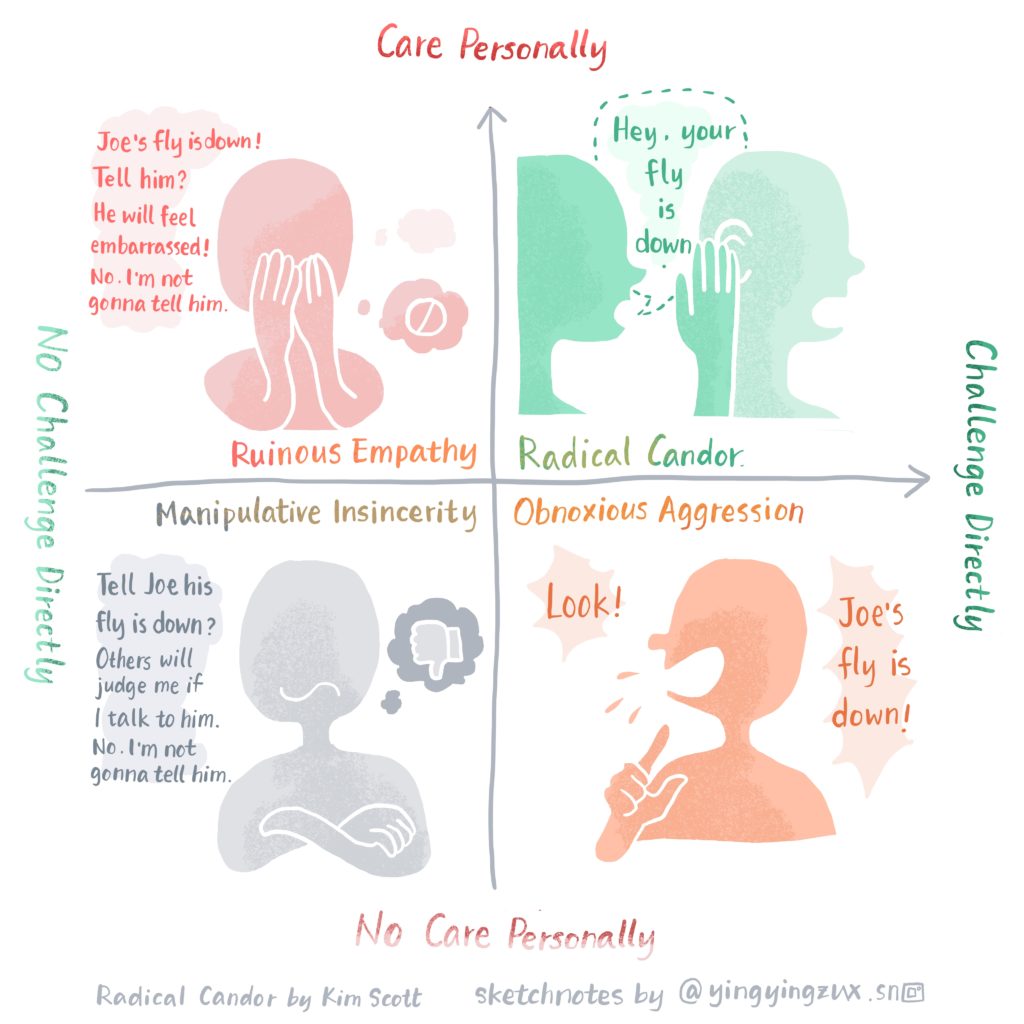
Show your radical candor when giving feedback, illustrated by Yingying
In a past project, I had a hard time collaborating with a colleague, and it was hindering my progress. At the time, I thought they intended to behave that way. I figured out that, only afterward, this resulted from their lack of experience in working with designers. During that unpleasant period, we had many misunderstandings and our relationship fell to a low point. Although I was constantly thinking about when and how to best give them feedback, I did not do a good job executing — my messages were muddy when I spoke and I waited too long. Eventually, things turned to be better after we got more familiar with each other’s work styles.
To this day, it still makes me think: if we were to have a candid feedback conversation about the situation, would things have got better much earlier? I think the answer is yes. If this ever happens again, that’s what I plan to do.
I know that I need to improve how I give feedback. In some cases, I think too much about what the other person would think of me if I speak up; in some other cases, I really want to say something but not sure how to express it in a good way.
Therefore, I read many articles and books on this topic. My favorite one so far is Radical Candor, by Kim Scott. Kim led teams at Google. Later, she started her own company to help people build better relationships at work.
Radical Candor brought lots of a-ha moments to me, and I hope to practice it in my work and life. Below are my takeaways from the book.
What is Radical Candor?
Radical Candor is a style of giving feedback. It means when you give feedback, you do not only care about them personally but can also challenge them directly.
I love this simple example from the book that explains what Radical Candor is and isn’t.
Your colleague Joe just steps out of the restroom, with the fly down and his white shirt sticking out. Tell him, or not? Tell him, he may feel embarrassed; stay silent, more people will see his ridiculousness. What would you do?
You can choose to pull him aside, and quietly tell him: “Joe, your fly is down. I did that before, too, and always appreciate the people who remind me of it. I hope you don’t mind that I mention this to you.” This way, you point out the problem directly, and also care about Joe’s feelings. This is Radical Candor.
You may choose to talk aloud when Joe passes the crowd: “Joe, your fly is down!” Yes, you do point out the problem, but you’re also stabbing Joe from the front — he will feel embarrassed for sure. This falls into Obnoxious Aggression.
If you know Joe is shy and sensitive, you may choose to stay silent, and hope he will find out by himself. But it may take some time for him to realize it — at which time, he would have looked like a fool in front of others for a while. In this case, your act falls into Ruinous Empathy. You may comfort yourself that staying silent is kind, however, the problem is not solved. Joe may also think, why you did not point it out as you walk past him.
Or, you choose to stay silent because you do not want others to judge you when you whisper to Joe. You don’t care about how Joe looks, instead, you care more about your own image. If you’re shameless, you may jokingly tell others about Joe’s fly, and laugh at him together. This falls into Manipulative Insincerity. This is the worst feedback fail because not only is the problem not solved, but also Joe’s little embarrassment magnifies.

These four quadrants do not label personalities. They are used to check if we fall into a specific feedback style — we could fall into any of them one time or another. It helps us to focus on be radically candid when giving feedback.
Be radically candid when giving feedback
First, have the right mindset. If you truly care about a person and want to help them grow, you consider their feelings. You strive to give them feedback in a good way that they can take it well. If your decision of giving feedback or not depends on what benefits it will bring to you, then you may be falling into the Manipulative Insincerity quadrant.
Next, pay attention to the way you give the feedback.
- Focus on the matter, not the person. Give a clear message, but express it humbly. Don’t say “you’re wrong” (Obnoxious Aggression), say, “I think that’s wrong, why do you think that’s a good way to do it?”
- Avoid giving superficial praises. Don’t praise just to make others feel better, instead, show them what’s valued.
- Provide constructive criticism, helping others know where to improve, what the next step is. If you do not have anything positive to say, but if that helps them grow, say it. If you try to sugarcoat criticism just to make it sound nicer, it may cause the message to be less clear. Be aware of falling into the Ruinous Empathy realm.
- Praise in public, criticize in private.
Besides, give feedback as soon as it’s needed, don’t save it up, for example, right after an important meeting. Giving honest feedback does not have to wait till you build a close relationship with the other person or a perfect moment. If you hold things back, they may question why you say nothing when you see problems. In fact, this may lower the trust between you.
Getting feedback
Reward the radical candor when you get feedback from others. Be attentive when listening to their feedback, clarify anything that’s not clear to you, so that you can fully understand what they mean. Make sure you follow up — you don’t need to take on every single suggestion, but you should follow up and let the feedback giver know why you follow or don’t follow certain advice. Proactively asking for feedback speeds up your growth, too.
Build a culture of Radical Candor
When a team leader leads by example, by constantly giving/getting feedback from the team, the team members learn to do it, too. Then, a healthy culture of giving and getting feedback starts forming.
I feel very fortunate of having such team leaders just like that, and they have deeply impacted me. I hope I’ll continue to get better and bring it to others as well.